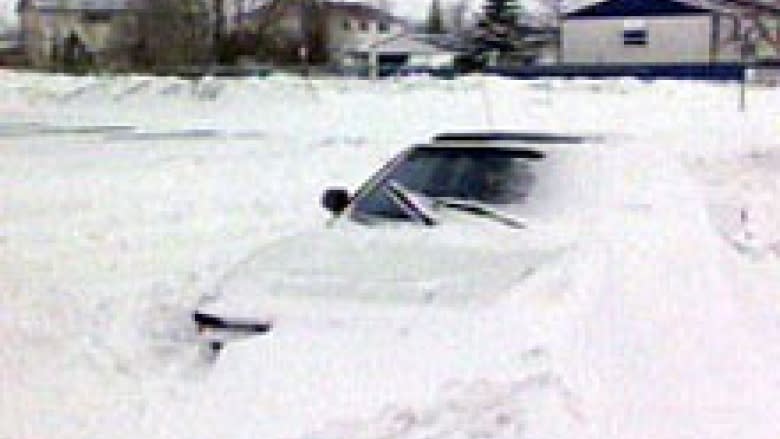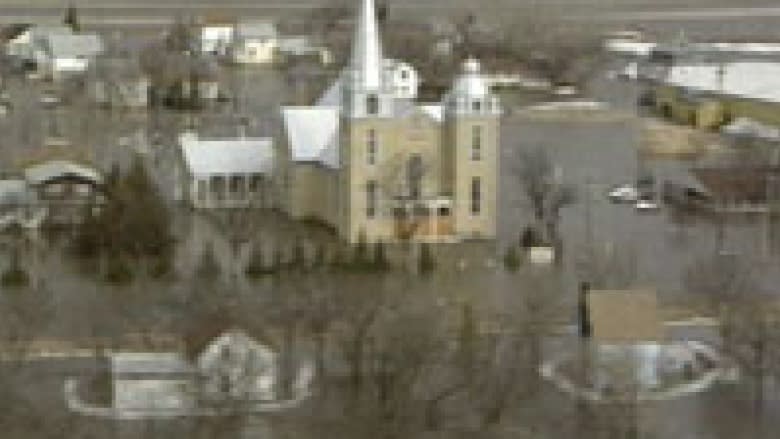'It wasn't pretty': Former flood forecaster recalls blizzard that led to Flood of the Century
Alf Warkentin knew we were in trouble when he looked out the window.
It was April 5, 1997, and he was looking at a blizzard.
"Back then, I could hardly see across the street for about 24 hours. It was something. That was one of the biggest storms ever," Warkentin said on Tuesday, almost 20 years to the day later.
"Yeah, during the height of that blizzard, I could barely see the trees on the other side of the street."
Warkentin, the province's senior flood forecaster at the time, suspected then what he'd later tell the province: the Flood of the Century was on its way.
In the next 24 hours, as much as 50 centimetres of snow fell on the Red River Valley, from Wahpeton, N.D. — south of Fargo — all the way to Winnipeg and north. The spring temperatures made it heavy, and the snow snapped power lines and caved in the roof of the Sears warehouse in Winnipeg's North End.
The blizzard was followed by an eerie silence, Warkentin says. Every highway and school in the south part of the province was closed. Drivers walked away from vehicles snowed-in on the roads.
For almost a day, no flights left the Winnipeg airport, stranding hundreds of passengers.
'It looked really bad'
For Warkentin, however, it was the start of a day-long sprint to put together a new flood forecast. As the only flood forecaster in the province at the time, he worked alone.
"I knew everybody wanted an update right away for the forecast. People wanted to know just exactly what are we facing, how much are we going to have to raise the dikes, if we have to," he said.
"A lot of people knew that something would have to be done. So I had to call Emergency Measures and they picked me up, took me to work, and I got right to work to update the forecast."
At the time, people who paid attention were already getting nervous, Warkentin said. There was already a lot of flooding in the Fargo, N.D., area, and the significant snowpack in the region didn't bode well. Towns in the Red River Valley were already talking about raising their ring dikes, but the idea was shot down by provincial management.
Warkentin finished his updated forecast a day after starting it.
"It wasn't pretty," Warkentin said.
"The new forecast came out a day later and, well, it wasn't the news that most people wanted to hear. It looked really bad, and they'd have to raise the ring dikes. All the valley towns would have to raise the ring dikes quite significantly."
Not everyone bought it right away.
"At that time there was still some questions about, well, is the forecast correct? And all eyes were looking south to Grand Forks and Fargo to see what's happening there," Warkentin said. "I think there was still quite a lot of doubters out there until the day when Grand Forks fell — it was April 19."
Most of the 60,000 people in Grand Forks were forced to evacuate the city as the waters rose, and an ensuing fire destroyed several of the city's historic buildings.
"Well, that was the moment of truth," Warkentin said. "I think everybody was a believer by that time."
Thanks to the blizzard, spring run-off levels doubled, raising river levels. Flooding eventually forced more than 28,000 Manitobans out of their homes and caused more than $500 million in damage in the province.
The Canadian military came in to help. At peak involvement, CBC news reported some 8,000 soldiers were in Manitoba, the largest Canadian deployment since the Korean War.
The storm was followed by a 10-day cold snap, Warkentin said — a stroke of luck in an unlucky season. Chilly weather kept the ground in the Red River Valley cold, giving heavy-machinery operators the chance to raise dikes around towns without slipping and sliding in wet clay.
If temperatures hadn't dropped, Warkentin said it might not have been the same story.
"They would've had a very difficult time," Warkentin said.
"I don't know if they would've made it, quite frankly."




